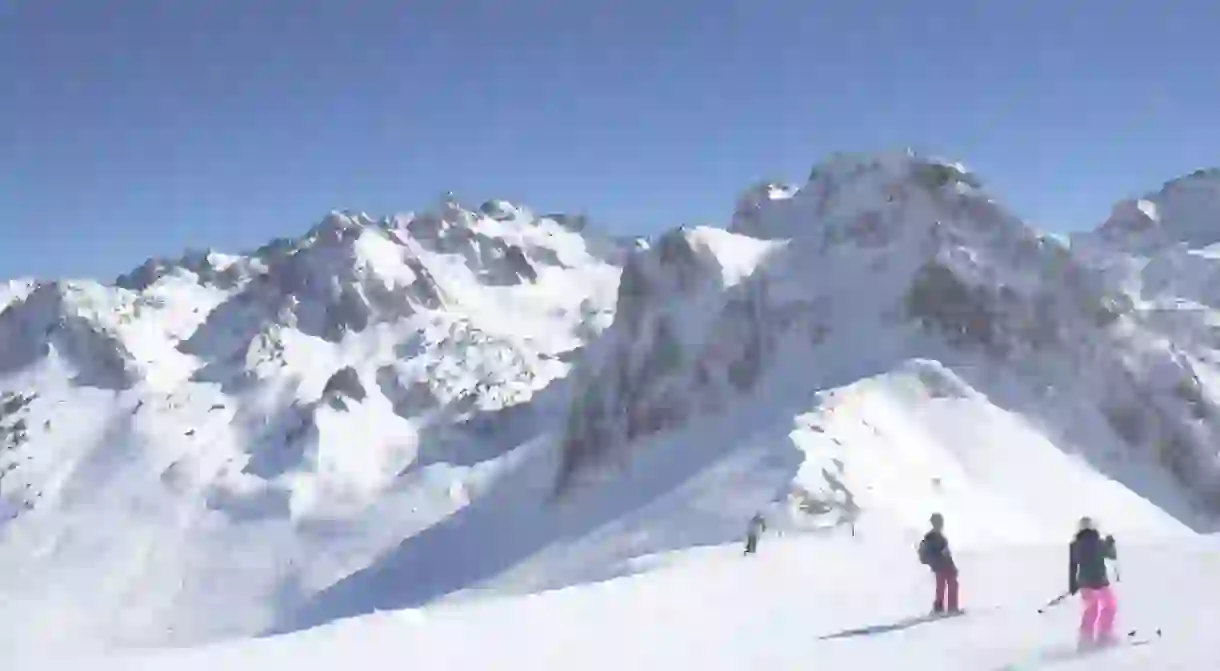The 10 Best Things to See and Do in the Pyrenees

Outdoor adventurers should add the French Pyrenees to their bucket list. Located in south-west France, the 430km long mountain range hugs the Spanish border. Ski the quiet slopes of Grand Tourmalet and enjoy hiking trail views of the Pic du Midi de Bigorre.
The crisp mountain air and cloudless blue skies of the Pyrenees offer the perfect setting for the region’s spectacular snow-capped peaks. Straddled between France and Spain, the mountain range north of the border forms part of one of France’s oldest national parks. Here, you are encouraged to be as free as the wildlife, with dozens of ways to actively immerse yourself in the scenery. From hiking and skiing to canyoning and stargazing, these are the top things to see and do in the French Pyrenees.
Hike the Cirque de Gavarnie
Natural Feature

Enjoy an overnight stay at Parc Animalier
Park, Natural Feature
It takes something special to be distracted from the spectacular Pyrenean backdrop, but Parc Animalier manages it with over 600 animals spread throughout 14 hectares of mountainside parkland. It’s divided into nine sections, including birds of prey, mountain dwellers, and grey wolf packs. For a more immersive experience, stay in one of their ecolodges where you can wake up overlooking the wolf or bear compounds.
Make the pilgrimage to Lourdes
Architectural Landmark

The small town of Lourdes enjoys global renown, thanks to alleged apparitions of the Virgin Mary witnessed by a 14-year-old girl in 1858. Since then, it has become a prominent shrine for Catholics wishing to bathe in the town’s spring water, which many believe to have curative benefits. Despite the town having a population of less than 15,000, some five million pilgrims make the trip every year.
Ride a cable car over the Pont d'Espagne
Natural Feature

As its name suggests, the Pont d’Espagne is a stone bridge that once connected France with Spain. This key trading route is now a beauty hotspot and hiking magnet. The reflective waters of Gaube Lake provide a glittering canvas on which to showcase Le Vignemale, the highest summit in the Pyrenees at 3,298 metres. The lake is a great place to picnic and can be reached via a serene 20-minute cable car journey. Hikers may prefer the 75-minute jaunt south along the signposted route G10.
Walk the Chemin des Cascades
Architectural Landmark
For hikers in search of a longer route to the Pont d’Espagne, a four-hour walking trail can be tacked on to the start of your journey. Simply park at La Raillere, where the aforementioned G10 trail begins. From here, you can follow the Marcadau mountain torrent for six miles southwest, taking in the six sloshing waterfalls (signposted in French as “cascades”) of the Jeret valley.
Relax at Bagneres-de-Bigorre
Architectural Landmark

The clue to this small commune’s main attraction is in its name, which is literally translated as “baths of Bigorre”. Snuggled into the foot of the Pyrenees along the banks of the Adour River, Bagnères-de-Bigorre’s thermal baths have made it a popular spa resort since Roman times. You’ll find Les Grands Thermes spa on Place des Thermes, where relaxation services include hydromassage, mud baths, and yoga.
Go canyoning at night at Saint-Lary-Soulan
Architectural Landmark

Like the idea of throwing yourself down a cascading waterfall attached to a piece of rope no thicker than your finger? Then you’ll have little trouble locating like-minded adrenaline-seekers in the Pyrenees. There are a number of companies that take advantage of the region’s mystical myriad of caves and canyons to offer intrepid trips for all ages. Canyoning Saint-Lary even offers night expeditions featuring zip lines and slides under a moonlit Barrosa Canyon.
Stargaze atop the Pic du Midi
Hiking Trail, Natural Feature

Towering 2,877 metres into the crisp and clear Pyrenean air, the Pic du Midi mountain is an ideal place for an observatory. Built at the turn of the 20th century, the domes of the Pic du Midi Observatory offer a magical panorama of the night sky. The view of the stars and planets is so impressive that NASA used the observatory to map the moon ahead of its historic Apollo missions. A cable car from the nearby town of La Mongie will get you there in 15 minutes, and overnight stays are available.
Ski at the Grand Tourmalet resort
Ski Resort
Accomplished skiers who wish to make their own way down from the observatory do have the option to freeride the return journey. Neither signposted nor patrolled, this route is not for beginners. Newbies should instead head for the nearby La Grand Tourmalet ski resort, which features both green and blue slopes. The largest ski area in the Pyrenees also has a number of black and red runs for more experienced skiers and snowboarders.
Visit the Château de Montségur
Historical Landmark
Delicately poised on a 1,200 metre-high pog – an Occitanian term meaning hill or peak – are the spectacular ruins of Montsegur Castle. A visit to this 13th century chateau makes for both an illuminating day trip and also an active hike. Bring good shoes and plenty of water before taking the 30-minute mountain path from the car park. There’s also a weavers trail that circles the castle at its base and takes around two hours.













